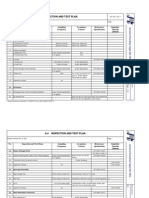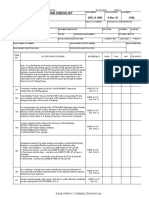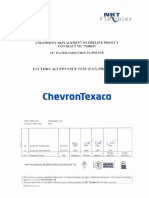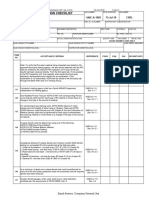Inspection Checklist (Icl) : Civil-Compaction Testing Inspection
Uploaded by
asif aziz khanInspection Checklist (Icl) : Civil-Compaction Testing Inspection
Uploaded by
asif aziz khanICL NUMBER DATE QR NUMBER
INSPECTION CHECKLIST (ICL) APPROVED
OCC-SEC-14870-
Compaction Testing Inspection ICL- A-0105
Civil-
PROJECT TITLE Contract No. CONTRACTOR / SUBCONTRACTOR
ITEM
ACCEPTANCE CRITERIA PASS FAIL N/A RE-INSP DATE
No.
1 Contractor's testing agency shall be a approved civil testing agency.
One Modified Proctor Test per ASTM D1557 with corresponding Proctor curve shall be performed for each
2
type of fill material or where there is a change in the type or the source of material.
For cohesionless free draining soils, ASTM D4253 Maximum Index Density and Unit Weight of Soils Using
a Vibratory Table and ASTM D4254 Minimum Index Density and Unit Weight of Soil and Calculation of
3
Relative Density shall also be performed for each type of cohesionless, free draining material or where
there is a change in the type or the source of material..
In-place density shall be determined using one of the following:
ASTM D-1556 Sand Cone Method;
4 ASTM D-2167 Rubber Balloon Method;
ASTM D-2922 Nuclear Method;
or ASTM D-2937 Drive-cylinder.
Acceptance testing of in-place density and moisture content (field density testing) on compacted fill will be
performed at the following rates:
1. Under all foundations - one test every 1000 ft² (90 m²) of each lift.
5 2. Under area paving - one test every 2000 ft² (180 m²) of each lift.
3. Road base and sub-base - one test every 2000 ft² (180 m²) of base or sub-base.
4. Backfill of trenches - one test for every 50 linear ft (15 m) of each lift.
5. General fill - one test every 5000 ft² (460 m²) of each lift.
As a minimum, at least one in-place density test must be performed on every lift of fill and further
6
placement shall not be allowed until the required density has been achieved.
Nuclear density gauges, when used, shall have a valid calibration certificate per the requirement of ASTM
7
D2922, Sec. A1.2.
Fill or backfill placed beneath footings, grade beams, mats, buildings or process areas shall be compacted
8
to at least 95% of the maximum Modified Proctor density as determined by ASTM D1557.
For cohesionless free draining soils, 70% relative density as determined by ASTM D4253 and ASTM
9
D4254 shall be achieved under footings, grade beams, mats, buildings or process areas.
Under foundations with static loads over 320kPa and foundations for vibrating or heavy machinery and
10 pavements, 85% of relative density (ASTM D4253/ASTM D4254) for cohesionless soils or 95% of of the
maximum density as determined by ASTM D1557 for cohesive materials.
When the backfill material cannot clearly be classified as cohesive or cohesionless both relative density
11
and Proctor density tests must be performed. The backfill shall then be compacted to the greater density.
The compaction requirement for base coarse shall not be less than 100% of the maximum laboratory dry
12
density as determined by ASTM D1557 or AASHTO T180..
The compaction requirement for subbase shall not be less than 95% of the maximum laboratory dry
13
density as determined by ASTM D1557 or AASHTO T180..
All other fill shall be compacted to the density equal to that shown on the drawings or equal to that
14
adjacent in-situ material as appropriate.
15 The depth of the test holes shall be no greater than 300mm (12 inches) deep. (ASTM D 2922, Sec. 1.1)
REMARKS:
REFERENCE DOCUMENTS:
CONTRACTOR SEC-SA
QaQc Civil Engineer Consultant Representative
Name, Initial & Date Name, Initial & Date
Page 1 of 1
You might also like
- Civil Inspector For ARAMCO Interview-Question & Answers (1) CTSA100% (5)Civil Inspector For ARAMCO Interview-Question & Answers (1) CTSA6 pages
- Tweed - The Frankfort-Mandibular Plane Angle in Orthodontic Diagnosis, Classification, Treatment Planning, and Prognosis PDFNo ratings yetTweed - The Frankfort-Mandibular Plane Angle in Orthodontic Diagnosis, Classification, Treatment Planning, and Prognosis PDF56 pages
- 11-KU-TWK-50-QA-PRO-2173 - 0 - Wrapping ProcedureNo ratings yet11-KU-TWK-50-QA-PRO-2173 - 0 - Wrapping Procedure8 pages
- Blasting Coating Procedure For Fabricated Steel Structure100% (1)Blasting Coating Procedure For Fabricated Steel Structure8 pages
- TR000-000-CW-ITP-00022_000_ITP 232 Asphalt Pavement_ITP 232 Asphalt PavementNo ratings yetTR000-000-CW-ITP-00022_000_ITP 232 Asphalt Pavement_ITP 232 Asphalt Pavement9 pages
- Concrete Quality Control Program Plan AYC-RSLF-CQCP-000No ratings yetConcrete Quality Control Program Plan AYC-RSLF-CQCP-0006 pages
- A Guide For FLUOR & BASF Painting Specification of Typical Storage Tanks (Part 03 of 05)No ratings yetA Guide For FLUOR & BASF Painting Specification of Typical Storage Tanks (Part 03 of 05)5 pages
- Hardness Test Procedure: 1 of 8 DE3511.006/ENo ratings yetHardness Test Procedure: 1 of 8 DE3511.006/E8 pages
- Standard Inspection & Test Plan (ITP) FOR Tank PadNo ratings yetStandard Inspection & Test Plan (ITP) FOR Tank Pad5 pages
- Saudi Aramco Inspection Checklist: Compaction Testing SAIC-A-1005 30-Apr-17 CivilNo ratings yetSaudi Aramco Inspection Checklist: Compaction Testing SAIC-A-1005 30-Apr-17 Civil3 pages
- Ml-09 Work Procedure For Field Joint Coating & RepairNo ratings yetMl-09 Work Procedure For Field Joint Coating & Repair11 pages
- GIPSOL - 2022 - 01 - 014 - Proposal For Building Pile Load TestNo ratings yetGIPSOL - 2022 - 01 - 014 - Proposal For Building Pile Load Test5 pages
- ATTL472-CL-MST-0001 METHOD STATEMENT For Switch GearNo ratings yetATTL472-CL-MST-0001 METHOD STATEMENT For Switch Gear24 pages
- 1.0 SCOPE:: SL - No. Tag No. Area of Exchanger Coating Thickness RemarksNo ratings yet1.0 SCOPE:: SL - No. Tag No. Area of Exchanger Coating Thickness Remarks5 pages
- 3.method Statement Backfilling and Compaction60% (5)3.method Statement Backfilling and Compaction5 pages
- Ultrasonic Examination Procedure Megha Engineering & Infrastructures LimitedNo ratings yetUltrasonic Examination Procedure Megha Engineering & Infrastructures Limited10 pages
- 4 - Technical Specifications For Piling Works - Pile Foundation For Tanks - ParadeepNo ratings yet4 - Technical Specifications For Piling Works - Pile Foundation For Tanks - Paradeep48 pages
- Blasting & Coating Procedure For Fabricated Steel Structure100% (1)Blasting & Coating Procedure For Fabricated Steel Structure8 pages
- FAT Test Procedure NKT Flexible Hose PDFNo ratings yetFAT Test Procedure NKT Flexible Hose PDF10 pages
- Method Statement For APCS-113A For Alloy Steel - Otc - Fbe-002100% (3)Method Statement For APCS-113A For Alloy Steel - Otc - Fbe-0027 pages
- P-005 Liquid Penetant Testing ProcedureNo ratings yetP-005 Liquid Penetant Testing Procedure13 pages
- Residential Asphalt Roofing Manual Design and Application Methods 2014 EditionFrom EverandResidential Asphalt Roofing Manual Design and Application Methods 2014 EditionNo ratings yet
- Advanced and Refractory Ceramics for Energy Conservation and EfficiencyFrom EverandAdvanced and Refractory Ceramics for Energy Conservation and EfficiencyHua-Tay LinNo ratings yet
- Ceramic Materials for Energy Applications V: A Collection of Papers Presented at the 39th International Conference on Advanced Ceramics and CompositesFrom EverandCeramic Materials for Energy Applications V: A Collection of Papers Presented at the 39th International Conference on Advanced Ceramics and CompositesJosef MatyášNo ratings yet
- Kuliah 9 - Analytical Hierarchy ProcessNo ratings yetKuliah 9 - Analytical Hierarchy Process17 pages
- Wittgenstein's Criticism of Russell's Theory of JudgmentNo ratings yetWittgenstein's Criticism of Russell's Theory of Judgment7 pages
- Guidelines On Legibility: Ar 512 HousingNo ratings yetGuidelines On Legibility: Ar 512 Housing12 pages
- John Jackman - Lighting For Digital Video and Television PDF100% (1)John Jackman - Lighting For Digital Video and Television PDF273 pages
- UBE Automotive MSA System Bias and Linearity StudiesNo ratings yetUBE Automotive MSA System Bias and Linearity Studies6 pages
- Electromagnetic Flow Meter Catalogue LJP (4310) PDFNo ratings yetElectromagnetic Flow Meter Catalogue LJP (4310) PDF14 pages
- An Introduction To Statistical LearningNo ratings yetAn Introduction To Statistical Learning19 pages
- cbse-class-9-social-science-sample-paperNo ratings yetcbse-class-9-social-science-sample-paper6 pages
- Map Showing The Fireline OF Brgy. Panggao Munai, Lanao Del NorteNo ratings yetMap Showing The Fireline OF Brgy. Panggao Munai, Lanao Del Norte1 page
- SPE-199091-MS, Electric Submersible Pump Troubleshooting Guide, An Effective Way To Improve System Performance and Reduce Avoidable System Failues100% (1)SPE-199091-MS, Electric Submersible Pump Troubleshooting Guide, An Effective Way To Improve System Performance and Reduce Avoidable System Failues18 pages

























































































